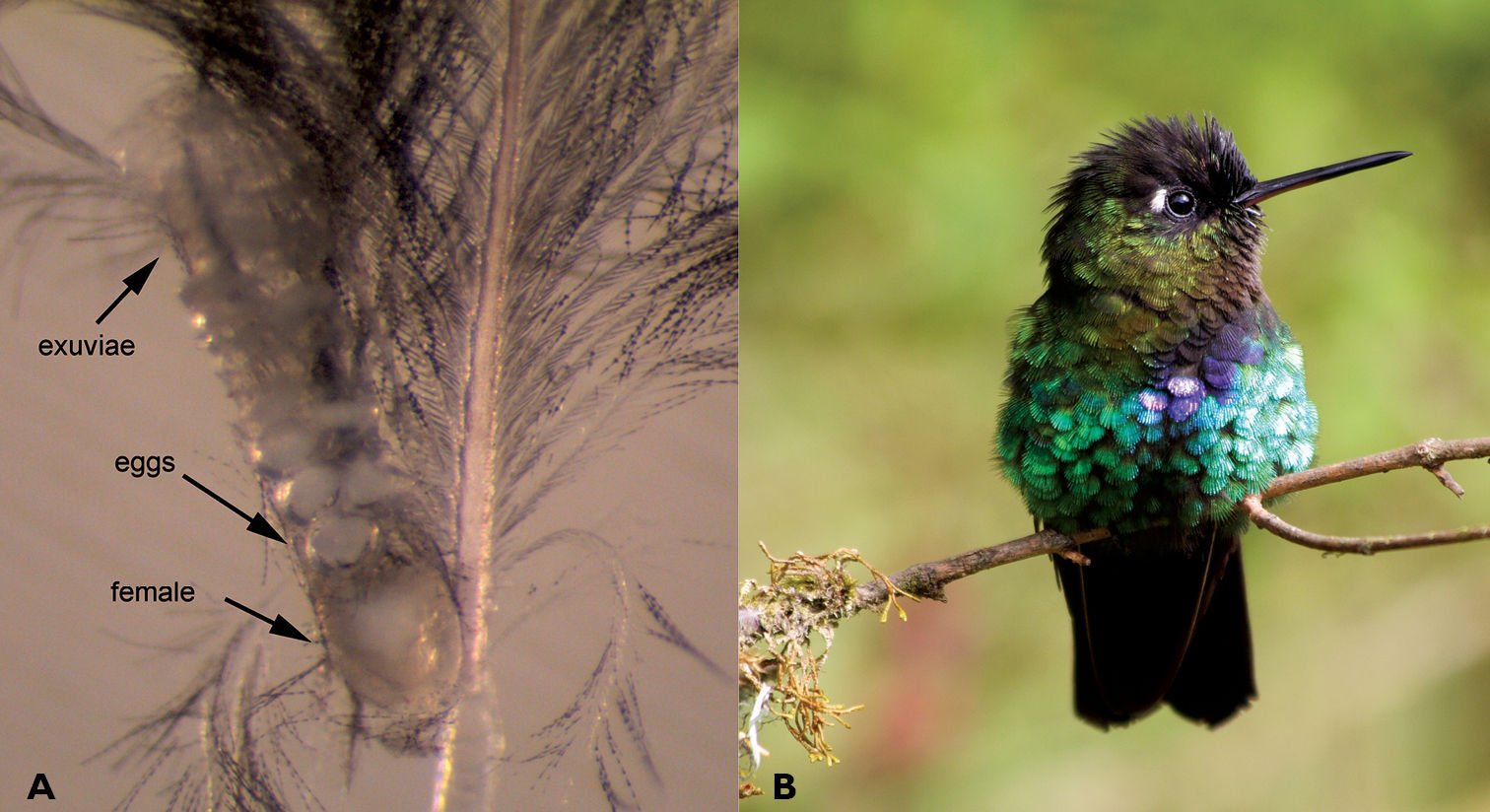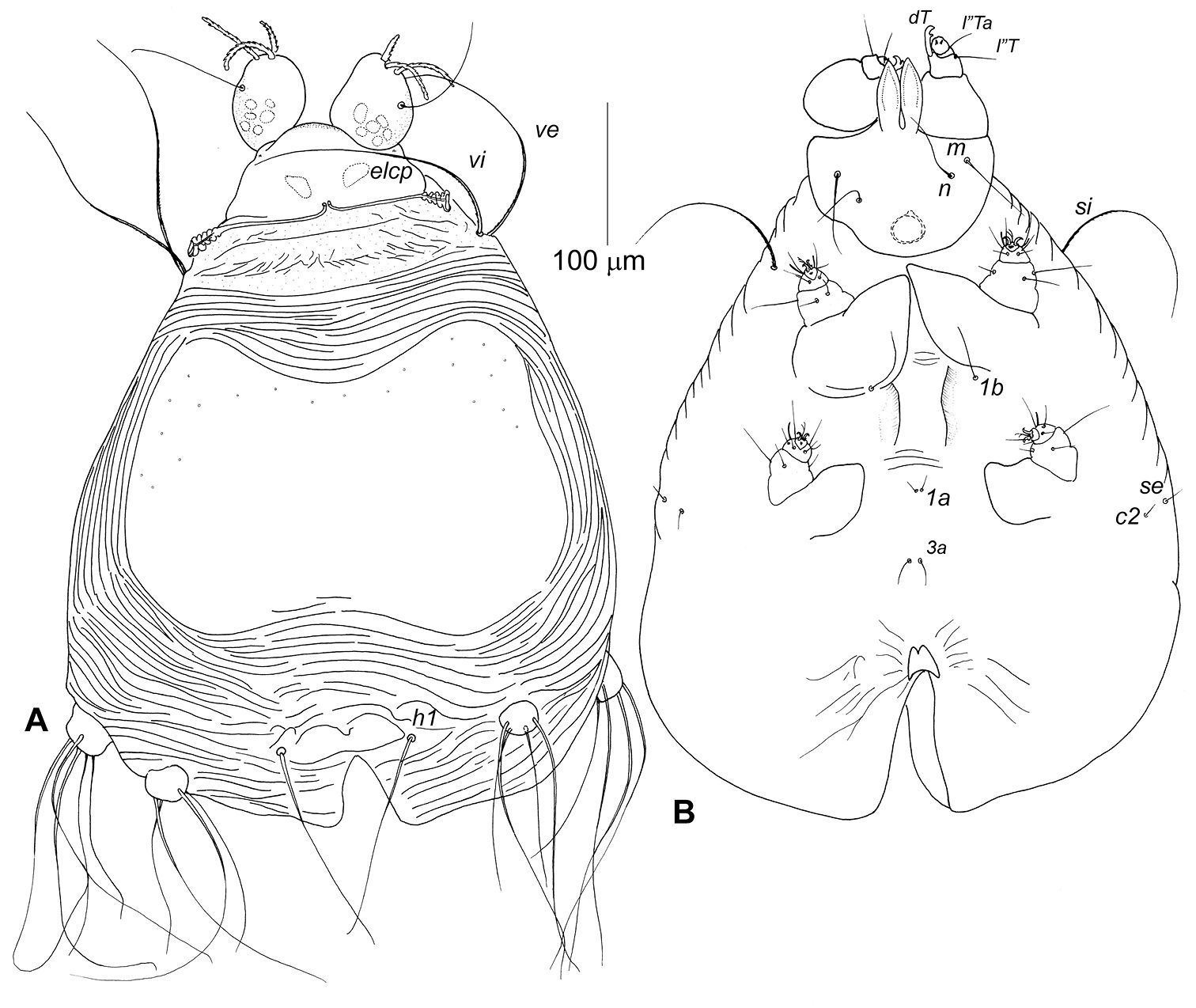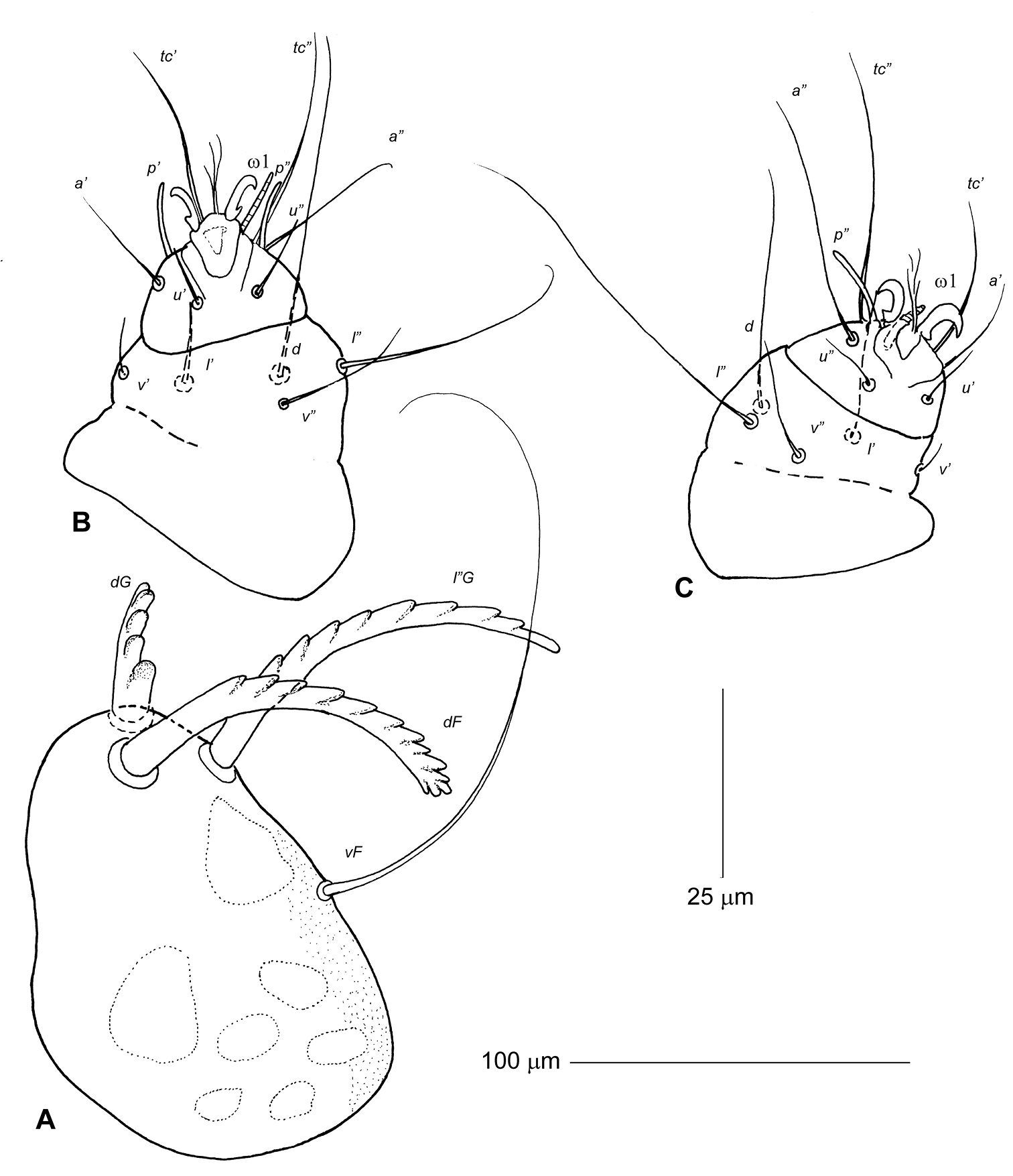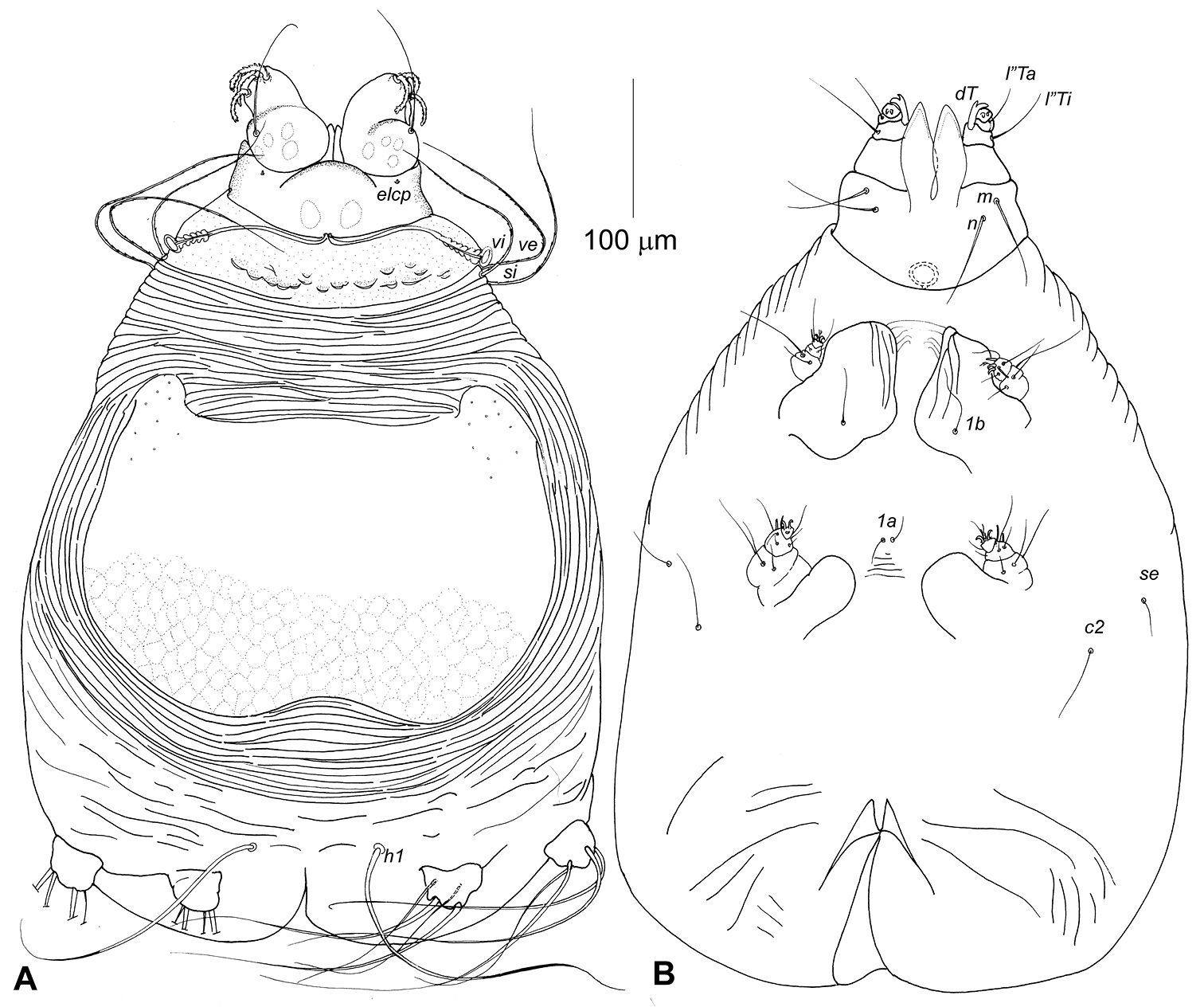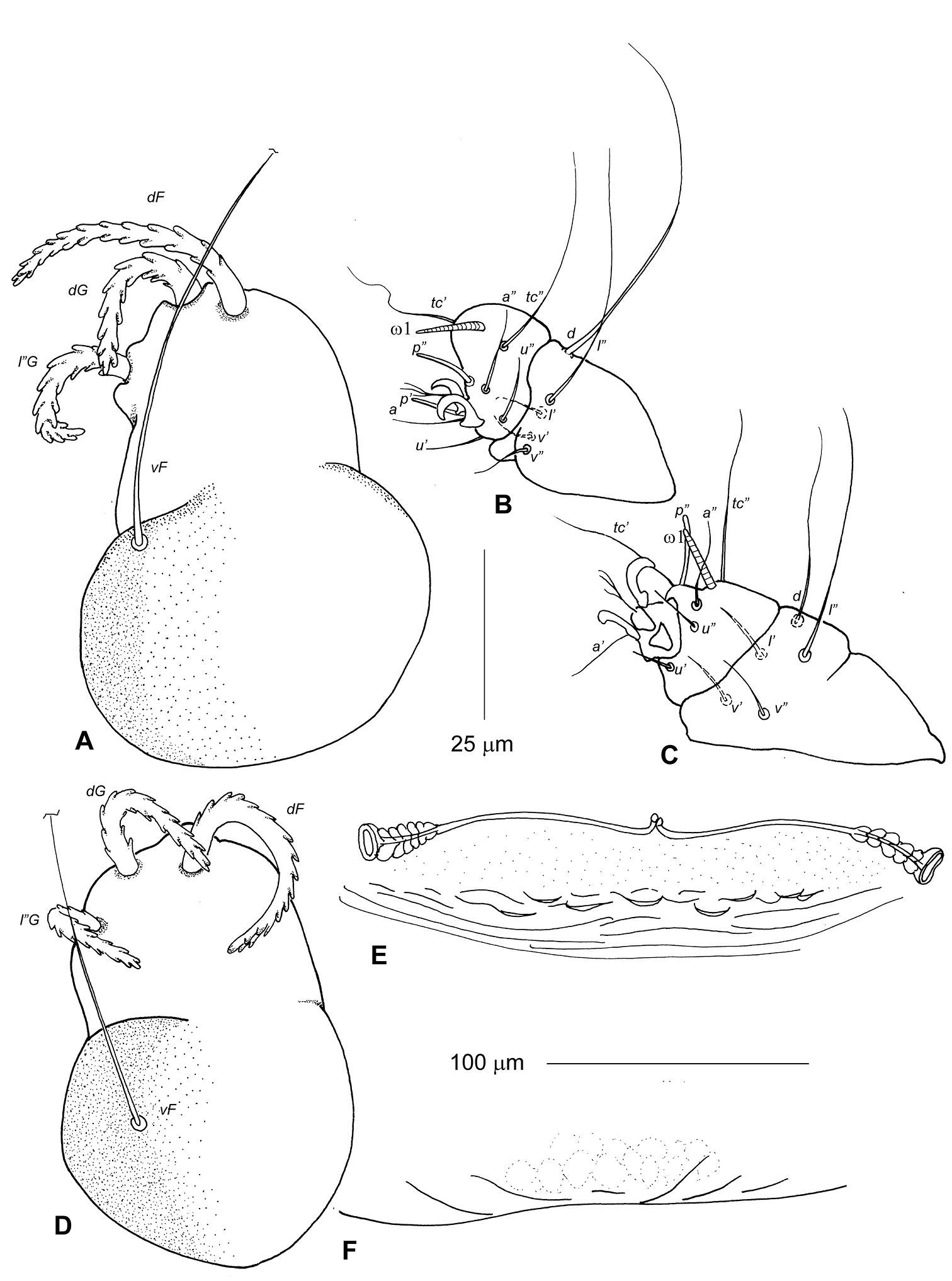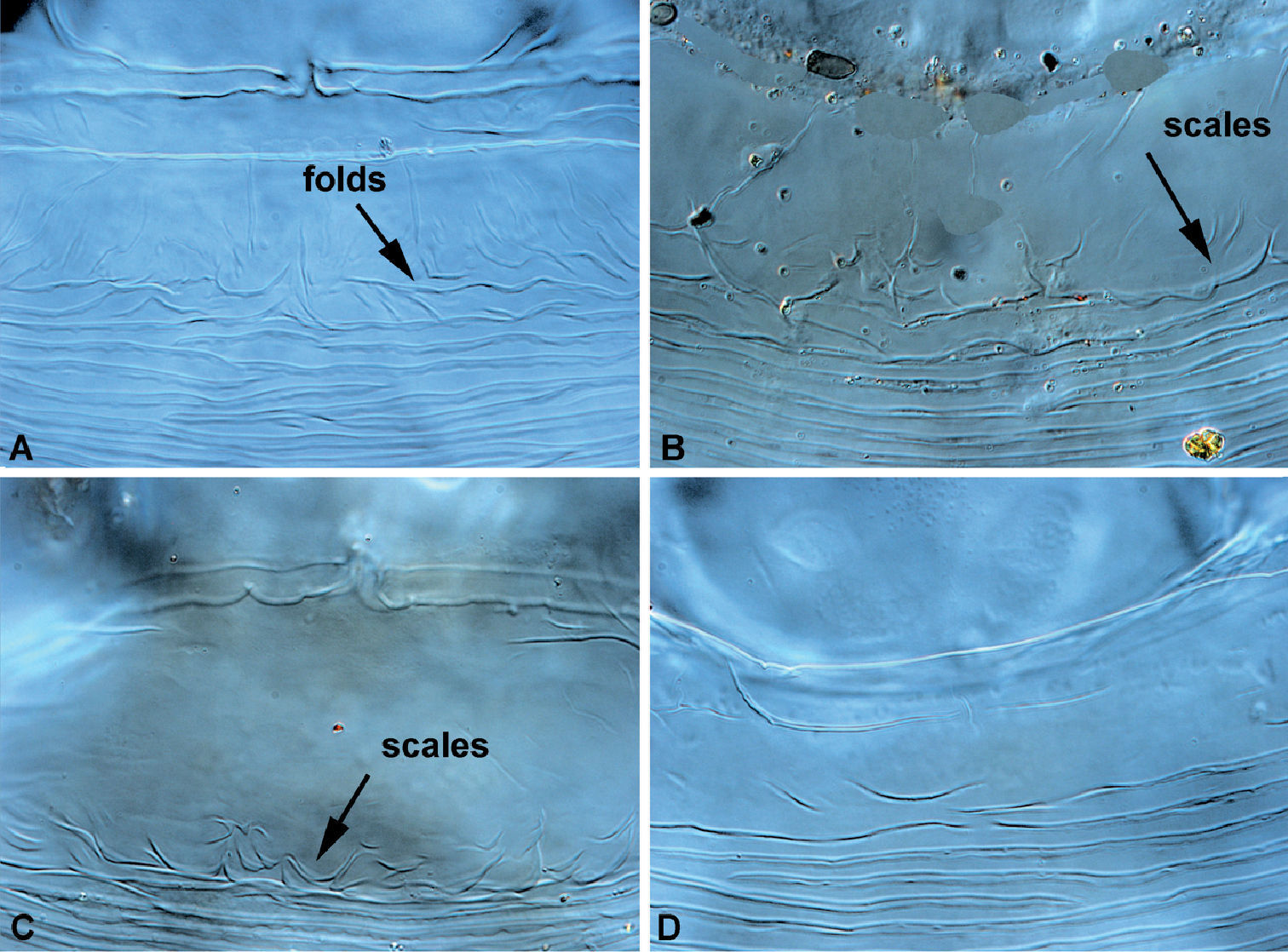(C) 2010 Bochkov Andre V.. This is an open access article distributed under the terms of the Creative Commons Attribution License, which permits unrestricted use, distribution, and reproduction in any medium, provided the original author and source are credited.
For reference, use of the paginated PDF or printed version of this article is recommended.
Three new species of parasitic mites of the genus Neharpyrhynchus Fain (Acariformes, Harpirhynchidae) are described from Neotropical birds: Neharpyrhynchus chlorospingus sp. n. from Chlorospingus pileatus (Passeriformes, Emberizidae) from Costa Rica, Neharpyrhynchus mironovi sp. n. from Dacnys cayana (Passeriformes, Thraupidae) and Neharpyrhynchus tangara sp. n. from Tangara cayana (Thraupidae) both from Brazil. Neharpyrhynchus trochilinus (Fain) is recorded from 3 new host species of the family Trochilidae (Apodiformes), Panterpe insignis and Eugenes fulgens from Costa Rica, and Amazilia lactea from Brazil. Emended diagnosis of the genus and a key to species are provided; all records of Neharpyrhynchus species are summarized.
Acariformes, Harpirhynchidae, Neharpyrhynchus, systematics, birds, parasites
Mites of the genus Neharpyrhynchus Fain (Acariformes, Harpirhynchidae) are permanent and highly specialized parasites of birds, as is the case for all other representatives of the subfamily Harpirhynchinae (
Most species of the genus are known from European passerines and only two species are known from Neotropical birds, Neharpyrhynchus baile Bochkov et al. from Turdus leucomelas (Passeriformes, Turdidae) (
Subdivision of the genus Neharpyrhynchus Fain on species groups. Characters:1 Setae vF: smooth (0), serrate (1) 2 Setae 3a: present (0), absent (1) 3 Number of articulated segments of leg I: 4 (0), 2 (1) 4 Number of articulated segments of legs II: 4 (0), 2 (1) 5 Number of articulated segments of legs IV: 2 (0), 1 (1) 6 Ornamentation of anterior region of propodsoma: absent or almost absent (0), present (1).
| Groups | Characters | Species | |||||
|---|---|---|---|---|---|---|---|
| 1 | 2 | 3 | 4 | 5 | 6 | ||
| baile | 1 | 0 | 0 | 0 | 1 | 0 | Neharpyrhynchus baile Bochkov et al., Neharpyrhynchus bochkovi Martinu et al., Neharpyrhynchus trochilinus (Fain) |
| plumaris | 0 | 0 | 1 | 1 | 1 | 1 | Neharpyrhynchus chlorospingus sp. n., Neharpyrhynchus novoplumaris (Moss et al.), Neharpyrhynchus plumaris (Fritsch), Neharpyrhynchus spinus Martinu et al. |
| pilirostris | 0 | 1 | 1 | 1 | 1 | 1 | Neharpyrhynchus hippolae Bochkov, Neharpyrhynchus mironovi sp. n., Neharpyrhynchus pari Martinu et al., Neharpyrhynchus pilirostris (Berlese & Trouessart), Neharpyrhynchus schoenobaenus Martinu et al., Neharpyrhynchus tangara sp. n. |
| squamiferus | 0 | 0 | 0 | 1 | 0 | 1 | Neharpyrhynchus squamiferus (Fain) |
Distribution of Neharpyrhynchus spp. on hosts.
“ - The same data as previous; * - type host; & - probably accidental record or wrong determination; @ - originally determined as Neharpyrhynchus plumaris Fritsch, 1954; $ - originally determined as Neharpyrhynchus novoplumaris Moss et al., 1968.
| Mite species | Host species | Host family and order | Locality | Reference |
|---|---|---|---|---|
| Neharpyrhynchus baile Bochkov et al., 2007 | *Turdus leucomelas Vieillot | Turdidae (Passeriformes) | Brazil (Mato Grosso do Sul) |
|
| Neharpyrhynchus bochkovi Martinu et al., 2008 | *Turdus merula Linnaeus | Turdidae (Passeriformes) | Czech Republic |
|
| Neharpyrhynchus chlorospingus sp. n. | *Chlorospingus pileatus Salvin | Emberizidae (Passeriformes) | Costa Rica | Present paper |
| Neharpyrhynchus hippolae Bochkov, 2000 | *Hippolais icterina (Vieillot) | Sylviidae (Passeriformes) | Russia (Novgorod Prov.) |
|
| Neharpyrhynchus mironovi sp. n. | *Dacnis cayana (Linnaeus) | Thraupidae (Passeriformes) | Brazil (Minas Gerais) | Present paper |
| Neharpyrhynchus novoplumaris (Moss et al., 1968) | *Certhia familiaris Linnaeus | Certhiidae (Passeriformes) | USA (California) |
|
| “ | Cardinalis cardinalis (Linnaeus) | Cardinalidae (Passeriformes) | USA (Maryland, Nebraska) |
|
| “ | &Campylorhynchus brunneicapillus (Lafresnaye) | Troglodytidae (Passeriformes) | USA (?) |
|
| “ | &Spizella passerina (Bechstein) | Emberizidae (Passeriformes) | USA (?) |
|
| “ | &Amphispiza bilineata (Cassin) | Emberizidae (Passeriformes) | USA (?) |
|
| “ | &Melozone fusca (Swainson) | Emberizidae (Passeriformes) | USA (?) |
|
| Neharpyrhynchus pari Martinu et al., 2008 | *Parus major (Linnaeus) | Paridae (Passeriformes) | Czech Republic |
|
| “ | Periparus ater (Linnaeus) | Paridae (Passeriformes) | Czech Republic |
|
| “ | @“ | “ | unknown |
|
| “ | Cyanistes caeruleus (Linnaeus) | Paridae (Passeriformes) | Czech Republic |
|
| “ | Poecile montanus (Baldenstein) | Paridae (Passeriformes) | Czech Republic |
|
| “ | Poecile palustris (Linnaeus) | Paridae (Passeriformes) | Czech Republic |
|
| “ | @“ | Paridae (Passeriformes) | unknown |
|
| “ | $Baeolophus bicolor (Linnaeus) | Paridae (Passeriformes) | USA (?) |
|
| Neharpyrhynchus pilirostris (Berlese & Trouessart, 1889) | *Passer domesticus (Linnaeus) | Passeridae (Passeriformes) | France |
|
| “ | “ | “ | Germany |
|
| “ | “ | “ | Czech Republic |
|
| “ | “ | “ | South Africa |
|
| “ | “ | “ | USA (Kansas) |
|
| “ | &Aegithalos caudatus (Linnaeus) | Aegithalidae (Passeriformes) | unknown |
|
| Neharpyrhynchus plumaris (Fritsch, 1954) | *Fringilla coelebs (Linnaeus) | Fringillidae (Passeriformes) | Germany |
|
| “ | “ | “ | Czech Republic |
|
| “ | “ | “ | Russia (Novgorod Prov.) |
|
| “ | &Muscicapa striata (Pallas) | Muscicapidae (Passeriformes) | Germany |
|
| “ | &Aythya ferina (Linnaeus) | Anatidae (Anseriformes) | Germany |
|
| Neharpyrhynchus schoenobaenus Martinu et al., 2008 | *Acrocephalus schoenobaenus (Linnaeus) | Sylviidae (Passeriformes) | Czech Republic |
|
| Neharpyrhynchus spinus Martinu et al., 2008 | *Spinus spinus (Linnaeus) | Fringillidae (Passeriformes) | Czech Republic |
|
| “ | @Carduelis cannabina (Linnaeus) | Fringillidae (Passeriformes) | Germany |
|
| Neharpyrhynchus tangara sp. n. | *Tangara cayana | Thraupidae (Passeriformes) | Brazil (Minas Gerais) | Present paper |
| Neharpyrhynchus trochilinus (Fain, 1972) | Hummingbird | Trochilidae (Apodiformes) | South America (?) | ( |
| “ | Chrysolampis mosquitus (Linnaeus) | Trochilidae (Apodiformes) | South America (?) |
|
| “ | Panterpe insignis Cabanis & Heine | Trochilidae (Apodiformes) | Costa Rica | Present paper |
| “ | Eugenes fulgens (Swainson) | Trochilidae (Apodiformes) | Costa Rica | Present paper |
| “ | Amazilia lactea (Lesson) | Trochilidae (Apodiformes) | Brazil (Minas Gerais) | Present paper |
| Neharpyrhynchus squamiferus (Fain, 1972) | *Temenuchus pagodarum (Gmelin) | Sturnidae (Passeriformes) | India (?) | ( |
Birds were examined by naked eye for the presence of
harpirhynchids and released back to the wild. S.V. Mironov and I.
Literak examined birds in the field. Mites were cleared in lactophenol
and mounted in Hoyer’s medium. Specimens were studied using a Leica
microscope under Nomarsky interference-contrast-phase (DIC) optics.
Drawings were made with a camera lucida, and measurements were taken
using a calibrated ocular micrometer. Drawings were made by A. V.
Bochkov. In the species description, names of the leg and idiosomal
setae follow (
The scientific names of birds follow the checklist of
Abbreviations:
CM # Ivan Literak field number;
INBio National Biodiversity Institute (Instituto Nacional de Biodiversidad), Heredia, Costa Rica;
IPCR Institute of Parasitology, Academy of Sciences of the Czech Republic, České Budějovice, Czech Republic
IRSNB Royal Belgian Institute of Natural Sciences (Institut Royal des Sciences Naturelles de Belgique), Brussels, Belgium;
MZUSP Zoological Museum of the University of São Paulo (Museu de Zoologia da Universidade de São Paulo), Brazil;
SVM # S. Mironov field number;
UMMZ University of Michigan Museum of Zoology, Ann Arbor, USA;
ZISP Zoological Institute of the Russian Academy of Sciences, Saint Petersburg, Russia;
ZISP AVB # number in collection of ZISP.
SystematicsFamily Harpirhynchidae Dubinin
Harpyrhynchus plumaris Fritsch, 1954: 193, figs 11, 12, by original designation
Females. Subcapitulum bearing setae n, m, and elcp; palp bearing setae vF, dF, dG, l”G, dT, l”T, l”Ta. Setae vF smooth or serrate, setae (=palpalae) dF, dG, and l”G grouped together, strongly thickened and roughly barbed. Membranous part of palpal tarsi bearing 2 microspurs. Idiosoma saccate. Anterior part of propodonotum sclerotized (see remark below); this sclerotized area smooth or sculptured. Dorsal shield distinctly developed, without ornamentation or finely ornamented. Idiosomal setae: vi, ve, and si set close to each other in anterior part of propodosoma, barbed filiform; se and c2 situated distinctly far from si; h1 – whip-like; 1a, 1b – fine, smooth filiform; setae 3a present or absent; setae scx and ag absent. Legs I–II moderately reduced, with distinct basal lobes; their pretarsi with pair of angled claws and ciliated empodium each. Leg I with 2–4 articulated segments. Tarsus I with 8 setae (tc’, tc”, p’, p”, a’, a”, u’, u”) and 1 straight solenidion ω1I; tibia I with 5 setae (d, l’, l”, v’, v”), two other proximal segments (if present) devoid of setae. Leg II with 2–4 articulated segments. Tarsus II with 7 setae (tc’, tc”, p”, a’, a”, u’, u”) and 1 straight solenidion ω1II; tibia II with 5 setae (d, l’, l”, v’, v”), two other proximal segments (if present) devoid of setae. Posterior legs III and IV bearing 4–6 setae each; legs III with 1 segment, legs IV with 1 or more rarely with 2 segments.
Males. Gnathosoma as in female. Idiosoma rhomboid in outline. Anterior sclerotized area of propodosoma absent. Dorsal shield well developed, occupying most part of dorsal idiosomal surface. Genital opening situated in middle part of dorsal shield. Genital setae 3 pairs. Penis originating behind genital opening. Situations of dorsal idiosomal setae typical for subfamily. Setae 3a present. Legs I and II well developed, without basal lobes, with 5 articulate segments each. Setation of tibia and tarsi as in females, three other proximal segments with setae. Legs III with two segments, both bearing setae; legs IV with one segment.
Neharpyrhynchus baile Bochkov et al., Neharpyrhynchus bochkovi Martinu et al., Neharpyrhynchus chlorospingus sp. n., Neharpyrhynchus hippolae Bochkov, Neharpyrhynchus mironovi sp. n., Neharpyrhynchus novoplumaris (Moss et al.), Neharpyrhynchus pari Martinu et al., Neharpyrhynchus pilirostris (Berlese & Trouessart), Neharpyrhynchus plumaris (Fritsch), Neharpyrhynchus schoenobaenus Martinu et al., Neharpyrhynchus spinus Martinu et al., Neharpyrhynchus squamiferus (Fain), Neharpyrhynchus tangara sp. n., and Neharpyrhynchus trochilinus (Fain).
Passeriformes: Aegithalidae, Cardinalidae, Certhiidae, Emberizidae, Fringillidae, Muscicapidae, Paridae, Passeridae, Sturnidae, Sylviidae, Thraupidae, Troglodytidae, Turdidae; Apodiformes: Trochilidae.
The sclerotized area on the anterior part of the
propodonotum was incorrectly named as the propodosomal (=propodonotal)
shield by
A Neharpyrhynchus chlorospingus sp. n., gravid female attached to host feather (photographed by A. V. Bochkov) B Panterpe insignis (Trochilidae) – host of Neharpyrhynchus trochilinus (Fain) (photographed by Z. Literakova).
urn:lsid:zoobank.org:act:60C5B820-F280-4D12-9C80-BE5B9D9B2BCD
Figs 2, 3, 6AFemale holotype (ZISP H-T-8, AVB 10-1210-001) and 4 female paratypes (ZISP AVB 10-1210-001, 1–4) from Chlorospingus pileatus Salvin (Passeriformes, Emberizidae) [feathers around ear apertures], COSTA RICA: Cerro de la Mueste, 9°34'N, 83°45'W, 13 August 2010, coll. I. Literak et al. (CM 112).
Holotype and 3 paratypes deposited in the ZISP, one paratype in the INBio.
Female (holotype). Idiosoma, including gnathosoma, 525 long (500–550 in 3 paratypes), 360 wide (350–360) (Fig. 2). Gnathosoma 130 long (130–145), 130 wide (130–140). Palps 50–60 long, moderately inflated dorsally. All palpalae distinctly pectinate (Fig. 3A). Lengths of palpalae: dF 35 (35–35), dG 20 (20–25), and l”G 50 (40–50); dG slightly thicker and about 2 times shorter than dF and l”G. Setae vF 100–110 long, smooth. Subcapitulum ventrally with setae n and m, about 40 and 50 long, respectively. Peritremal branch about 85 long. Idiosoma 425 long (420–440). Anterior region of propodonotum covered by short irregularly situated folds, without scales or tubercles (Fig. 6A). Dorsal shield entire, 165 long in midline (160–170), 300 at maximum width (300–330) (Fig. 2A). Anterior and posterior margins of dorsal shield widely concave. Ventral surface of idiosoma with indistinct transverse striations, without scales or verrucosities (Fig. 2B). Setal lengths: vi, ve, and si - all distinctly barbed, subequal in length, 150–160; se, c2, and 1a - all smooth, 10–12; h1 whip-like, 250 (230–260); 1b smooth, about 40; 3a present, about 20. Base of legs I with distinctly developed and slightly attenuated fleshy lobe; base of legs II with moderately developed rounded lobe. Leg I with 2 articulated segments (Fig. 3B). Leg II with 2 articulated segments (Fig. 3C). Legs III, IV with one segment, each bearing 4 (more rarely 5) long setae. One ventral seta of leg III and 2 ventral seta of leg IV 100–120 long, about half the length of other setae situated dorsally or dorsoterminally, 200–250 long.
Male. Unknown.
Neharpyrhynchus chlorospingus sp. n., female holotype, A dorsal view B ventral view.
Neharpyrhynchus chlorospingus sp. n., details of female holotype, A palp in dorsal view B leg I in dorsal view C leg II in dorsal view.
The species name is derived from the generic name of the host and is a noun in apposition.
This species belongs to the “plumaris” species group including three species, Neharpyrhynchus plumaris (Fritsch), Neharpyrhynchus novoplumaris (Moss et al.), and Neharpyrhynchus spinus Martinu et al. (
urn:lsid:zoobank.org:act:07B0EB50-C713-417B-AAA4-0B240A93AA7D
Figs 4, 5A–C, 6BFemale holotype (MZUSP), 20 female paratypes (ZISP AVB 10-1210-002, #1–20) on slides and numerous paratypes preserved in alcohol from Dacnis cayana (Linnaeus) (Passeriformes, Thraupidae) [feathers around ear apertures, back of the head and neck], BRAZIL: Minas Gerais, Belo Horizonte, Nova Lima, Área de Proteção Permanente (Permanent area for protection) do Condomínio Miguelão, 20°07'S, 43°58'W, 8 September 2010, coll. S.V. Mironov et al. (SVM-10-0908-1).
Holotype and 10 paratypes deposited in the MZUSP, 6 paratypes in the ZISP, 2 paratypes in the UMMZ, and 2 paratypes in the IPCR. Alcohol preserved paratypes deposited in the MZUSP and ZISP.
Female (holotype). Idiosoma, including gnathosoma, 675 long (660–680 in 10 paratypes), 425 wide (420–435) (Fig. 4). Gnathosoma 135 long (130–140), 150 wide (140–155). Palps 65–75 long, distinctly inflated dorsally. All palpalae distinctly pectinate (Fig. 5A). Lengths of palpalae: dF 40 (38–40), dG 30 (28–33), and l”G 30 (30–35); dF only slightly longer than dG and l”G. Setae vF about 100 long, smooth. Subcapitulum ventrally with setae n and m, about 80 long. Peritremal branch about 120 long. Idiosoma 525 long (510–530). Anterior region of propodonotum covered by short rounded scales situated irregularly in its posterior half (Fig. 6B). Dorsal shield entire, 200 long in midline (190–200), 350 at maximum width (350–370) (Fig. 4A). Anterior margin of dorsal shield almost straight, with pair of lateral anteriorly directed projections; posterior margin with distinct median concavity. This shield covered by fine rhomboid-like pattern, almost indistinct in anterior half and more clearly discernible in posterior half. Ventral surface of idiosoma with indistinct transverse striations, without scales or verrucosities (Fig. 4B). Setal lengths: vi, ve, and si - all distinctly barbed, subequal in length, 160–175; se and 1a 12–25, c2 50–60- all smooth; h1 whip-like, 250 (250–280); 1b smooth, 30–40, 3a absent. Base of legs I with distinctly developed fleshy lobe partially covering leg segments; base of legs II with moderately developed rounded lobe. Leg I with 2 articulated segments (Fig. 5B). Leg II with 2 articulated segments (Fig. 5C). Legs III, IV with one segment, each bearing 4 long setae. One ventral seta of leg III and 2 ventral seta of leg IV about 150 long, about half the length of other setae situated dorsally or dorsoterminally, 250–300 long.
Male. Unknown.
Neharpyrhynchus mironovi sp. n., female holotype, A dorsal view B ventral view.
The species is named in honour of the prominent Russian acarologist Dr. Sergey V. Mironov (ZISP).
It is close to species of the group “pilirostris”. In all these species, setae vF are smooth, only two articulated segments on legs I and II are present, and setae 3a are absent. Among species of this group, Neharpyrhynchus mironovi is close to Neharpyrhynchus pari by the presence of four setae on leg III and by irregular ornamentation of the anterior part of the propodosoma. The new species differs fromNeharpyrhynchus pari by the following characters. In females of Neharpyrhynchus mironovi, the palps are distinctly inflated dorsally, the ornamentation of the anterior part of the propodonotum is scale-like and present only in the posterior half of this region, setae c2 are 50–60 long. In Neharpyrhynchus pari, the palps are moderately inflated dorsally, the anterior part of the propodonotum is fully ornamented by verrucosities and setae c2 are 5–6 long.
urn:lsid:zoobank.org:act:5C1328B7-9A79-445A-AFB6-BC5402DFC36C
Fig. 5D–F, 6CFemale holotype (MZUSP), 20 female paratypes (ZISP AVB 10-1210-003, 1–20) on slides and numerous paratypes preserved in alcohol from Tangara cayana (Linnaeus) (Passeriformes, Thraupidae) [feathers around ear apertures, back of the head and neck], BRAZIL: Minas Gerais, Belo Horizonte, Nova Lima, Água Limpa, 20°13'S, 43°56'W, 31 August 2010, coll. S.V. Mironov et al. (SVM-10-0831-12).
Holotype and 10 paratypes deposited in the MZUSP, six paratypes in the ZISP, 2 paratypes in the UMMZ, and 2 paratypes in the IPCR. Alcohol preserved paratypes deposited in the MZUSP and ZISP.
Female (holotype). Idiosoma, including gnathosoma, 600 long (600–620 in 10 paratypes), 380 wide (380–400). Gnathosoma 125 long (125–130), 150 wide (145–150). Palps 60 long, distinctly inflated dorsally. All palpalae distinctly pectinate (Fig. 5D). Lengths of palpalae: dF 35 (35–40), dG 30 (29–33), and l”G 29 (30–32); dF only slightly longer than dG and l”G. Setae vF about 90 long, smooth. Subcapitulum ventrally with setae n and m, about 70 long. Peritremal branch about 110 long. Idiosoma saccate, 500 long (500–520). Anterior region of propodonotum covered by short rounded scales situated irregularly in its posterior half (4E, 5C). Dorsal shield entire, 190 long in midline (180–200), 330 at maximum width (330–350). Anterior margin of dorsal shield almost straight with pair of lateral anteriad directed projections; its posterior margin almost straight (4F). This shield covered by fine rhomboid-like pattern, almost indistinct in anterior half and slightly better discernible in posterior half. Ventral surface of idiosoma with indistinct transverse striations, without scales or verrucosities. Setal lengths: vi, ve, and si - all distinctly barbed, subequal in length, 150–170; se, c2, and 1a 8–12- all smooth; h1 whip-like, 230 (210–240); 1b smooth, 30–35, 3a absent. Legs as in previous species.
Male. Unknown.
The species name derives from the generic name of the host and is a noun in apposition.
This new species is closest to Neharpyrhynchus mironovi and differs by the following characters. In females of Neharpyrhynchus tanagra, setae c2 are 8–12 long, the posterior margin of the dorsal shield is almost straight. In Neharpyrhynchus mironovi, setae c2 are 50–60 long, the posterior margin of the dorsal shield is widely concave. Both species are collected from the hosts belonging to the family Thraupidae.
Fig. 6D
26 females (ZISP AVB 10-1210-004, 1–26) from Panterpe insignis Cabanis & Heine (Apodiformes, Trochilidae) [feathers of neck], COSTA RICA: Cerro de la Mueste, 9°34'N, 83°45'W, 14 August 2010, coll. I. Literak et al. (CM 199); 10 females from same host (ZISP AVB 10-1210-005, 1–10) and locality, 11 August 2010, coll. I. Literak et al. (CM 13); 10 females (ZISP AVB 10-1210-006, 1–10) from same host and locality, 13 August 2010, coll. I. Literak et al. (CM 151).
20 females (ZISP AVB 10-1210-007, 1–20) from Eugenes fulgens (Swainson) (Passeriformes, Trochilidae) [feathers of head, chest, and neck], COSTA RICA: Cerro de la Mueste, 9°34'N, 83°45'W, 13 August 2010, coll. I. Literak et al. (CM 152).
27 females (ZISP AVB 10-1210-008, 1–27) from Amazilia lactea (Lesson) (Apodiformes, Trochilidae) [feathers of head and neck], BRAZIL: Minas Gerais, Belo Horizonte, Nova Lima, Área de Proteção Permanente (Permanent area for protection) do Condomínio Miguelão, 20°07'S, 43°58'W, 4 September 2010, coll. S.V. Mironov et al. (SVM-10-0904-1).
This species was briefly diagnosed from both sexes collected from an unidentified species of hummingbird (Trochilidae)
that originated from South America (exact locality unknown) and died in
the Zoo of Antwerp (Belgium) during its quarantine. Later on,
The longitudinally subdivided dorsal shield of this species is an artifact sometimes induced by the mite mounting. In this species, actually, the dorsal shield is entire. It differs from the closely related Neharpyrhynchus baile Bochkov et al. by the following characters. In females of Neharpyrhynchus trochilinus, setae dF, dG, and l”G are subequal, legs III and IV with 5–6 setae each, setae si and se 25–35 long. In Neharpyrhynchus baile, setae dF is about 1.5 times longer than dG and l”G, legs III and IV as a rule with 4 setae each, setae si and se are 6–12 long.
Neharpyrhynchus spp, details of females. Neharpyrhynchus mironovi sp. n., holotype (A–C), A palp in dorsal view B leg I in dorsal view C leg II in dorsal view; Neharpyrhynchus tangara sp. n. (D–F), D palp in dorsal view E anterior part of propodonotum F posterior margin of dorsal shield. Scale bars: A–D = 25 μm; E and F = 100 μm.
Neharpyrhynchus spp, anterior part of propodonotum, A Neharpyrhynchus chlorospingus sp. n. B Neharpyrhynchus mironovi sp. n. C Neharpyrhynchus tangara sp. n. D Neharpyrhynchus trochilinus (Fain).
(based on
| 1 | Anterior margin of propodonotum without ornamentation or just with few striations. Palpal seta vF serrate. Legs II with 4 articulate segments | 2 |
| – | Anterior margin of propodonotum ornamented. Palpal seta vF smooth. Legs II with 2 articulate segments | 4 |
| 2 | Palpal setae dF 1.4–1.5 times longer than dG and l”G. Setae si and c2 short, 6–12 long. Leg IV normally with 4 setae (rarely with 5 setae) | 3 |
| – | Palpal setae dF, dG, and l”G subequal in length. Setae si and c2 relatively long, 25–35 long. Leg IV normally with 5 setae (rarely with 6 setae) | Neharpyrhynchus trochilinus Fain, 1972 |
| 3 | Lengths of palpal setae dF, dG, and l”G 58–70, 40–49, and 42–53, respectively. Leg III normally with 5 setae (rarely with 4 setae) | Neharpyrhynchus bochkovi Martinu et al., 2008 |
| – | Lengths of palpal setae dF, dG, and l”G 45–54, 30–44, and 30–39, respectively. Leg III normally with 4 setae (rarely with 5 setae) | Neharpyrhynchus baile Bochkov et al., 2007 |
| 4 | Legs I with 2 segments; legs IV with 1 segment. Scales on ventral surface of idiosoma absent | 5 |
| – | Legs I with 4 segments; legs IV with 2 segments. Scales on ventral surface of idiosoma present | Neharpyrhynchus squamiferus (Fain, 1972) |
| 5 | Setae 3a absent | 6 |
| – | Setae 3a present | 11 |
| 6 | Posterior margin of dorsal shield without distinct median suture. Anterior part of propodosoma ornamented by verrucosities, flat cells or widely rounded scales | 7 |
| – | Posterior margin of dorsal shield with distinct median suture reaching 1/3 of shield length. Anterior part of propodosoma ornamented by irregular striae (folds) | Neharpyrhynchus schoenobaenus Martinu et al., 2008 |
| 7 | Palpal femur distinctly inflated dorsally. Anterior part of propodonotum ornamented only in posterior half by widely rounded scales | 8 |
| – | Palpal femur moderately inflated dorsally. Anterior part of propodonotum fully ornamented by verrucosities or closed cells | 9 |
| 8 | Setae c2 8–12 long. Posterior margin of dorsal shield almost straight | Neharpyrhynchus tanagra sp. n. |
| – | Setae c2 50–60 long. Posterior margin of dorsal shield widely concave | Neharpyrhynchus mironovi sp. n |
| 9 | Anterior part of prodorsum covered by irregularly situated verrucosities, not forming transverse rows. Dorsal shield covered by fine ornamentation. Legs III normally with 4–6 setae | 10 |
| – | Anterior part of prodorsum covered by verrucosities forming 4–5 transverse rows. Dorsal shield without ornamentation. Legs III with 4 setae | Neharpyrhynchus pilirostris (Berlese & Trouessart, 1889) |
| 10 | Dorsal shield 140–165 long, covered by fine longitudinal striation. Legs III with 5–6 setae | Neharpyrhynchus pari Martinu et al., 2008 |
| – | Dorsal shield 165–195 long, covered by fine irregular transverse scale-like striation. Legs III with 4–5 setae | Neharpyrhynchus hippolae Bochkov, 2000 |
| 11 | Palpal setae dG about half the length of l”G | 12 |
| – | Palpal setae dG and l”G subequal | 13 |
| 12 | Palpal setae dF slightly shorter than l”G. Setae se and c2 about 4 times shorter than setae 1b. Posterior margin of dorsal shield widely concave | Neharpyrhynchus chlorospingus sp. n. |
| – | Palpal setae dF slightly longer than l”G. Setae se and c2 subequal or only slightly shorter than setae 1b. Posterior margin of dorsal shield widely convex | Neharpyrhynchus novoplumaris Moss et al., 1968 |
| 13 | Anterior part of propodonotum covered by longitudinal striation only in posterior part. Palpal setae vF 75–80 long. Dorsal shield 307–345 wide, covered by fine longitudinal scale-like pattern | Neharpyrhynchus plumaris (Fritsch, 1954) |
| – | Anterior part of propodonotum completely covered by longitudinal striations. Palpal seta vF 98–108 long. Dorsal shield 275–280 wide, devoid ornamentation | Neharpyrhynchus spinus Martinu et al., 2008 |
We thank Dr. S.V. Mironov (ZISP, Russia) who provided us with Neharpyrhynchus samples collected by him in Brazil. We thank Drs. M. Capek, F.A. Hernandes, F. Kounek, M. Literakova, B. Calvo Rodriguez, O. Sychra, and M. Valim for the cooperation in the field. Mites were collected from birds under permits No. 24789–1 (IBAMA, Brazil) and No. 120-2010-SINAC (MINAET, Costa Rica). This research was supported by grants No. 10-04-00160 and No. IAA601690901 from the Russian Foundation for Basic Research and the Grant Agency of the Academy of Sciences of the Czech Republic, respectively.







